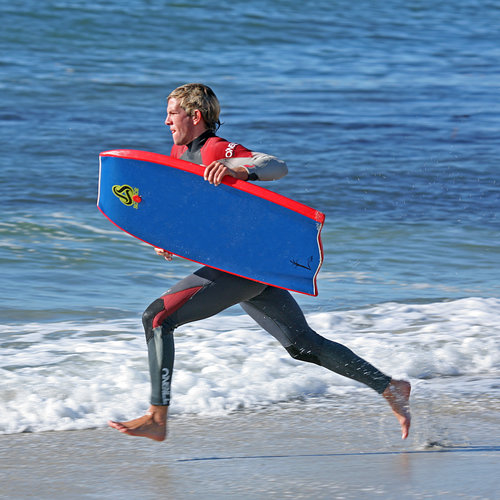Today I went bodyboarding for the first time, and I think I’m addicted.
I’m currently down in Santa Monica visiting a friend from college.
This morning we decided to come out to the beach over near Malibu to get some sun and spend some time in the water.
I’ll admit that I wasn’t actually planning on bodyboarding much.
I’ve never done it before, and I kind of just wanted to have a relaxing morning on the sand.
But floating around in the waves just looked too fun.
My first few attempts were quite sad. I would either float over the top of the wave or just get pummeled by the breaking surf.
After a couple of hours, and dozens of attempts, I finally got the hang of it. I was riding waves all the way to the shore.
And that’s what I want to share with you today: the secret of bodyboarding.
Ready? OK.
It’s all about timing.
Jump too early, and you’ll be crushed. You won’t go very far (and you’ll get a mouthful of salt water).
Jump too late, and you’ll miss the wave altogether. It will just pass right on by, and you’ll be floating there in the same exact place where you started.
If you jump off right as the wave is cresting, though, you’ll be carried forward near its peak—all the way to the shore.
Timing. Timing. Timing.
Since I’m a psychology nerd, I saw the whole thing as a great metaphor for behavior-change.
So much of my work is dedicated to figuring out the best time to ask people to do things.
When is the best time to ask someone to download an app? What about getting them to purchase a second order? Etc.
In the world of behavior design, a request (also called a call-to-action) is called a trigger.
If you trigger someone to do a behavior when they are able and motivated to perform it, it’s very likely that they’ll follow through.
But what if you trigger them too early—when they’re not quite ready (or motivated) to do the behavior? Yep, you got it. They won’t do it. You’ve caused them to jump too early.
And what about a late trigger—one that happens when they’re no longer motivated (or able) to do what you want them to do? Same thing. The wave will pass them by, leaving them in the same place they started.
So, the next time you’re trying to change your (or someone else’s) behavior, think of a bodyboarder floating in the ocean, waiting to catch a perfect wave… and remember that the difference between success and failure is timing.
If you trigger when ability and motivation are highest, you’ll almost never fail.
Until tomorrow,
Jason
PS: The model of behavior that I cover in this email is called the Fogg Behavior Model. You should check it out.
PPS: You should become one of my first supporters on Patreon. Why? Because it would mean the world to me… and, as a gift for your support, you will get access to my future products/books before they’re released, and you can even get access to an exclusive monthly Google Hangout I’m going to start hosting. Sign up before the slots fill up.





